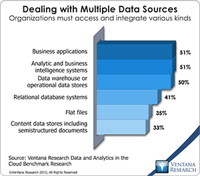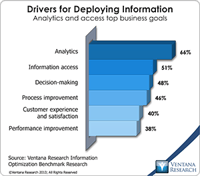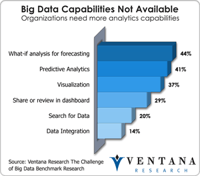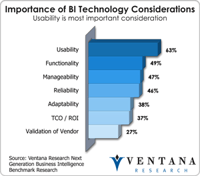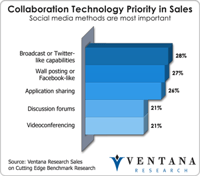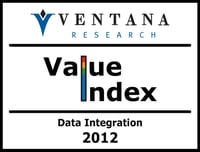As I discussed in the state of data and analytics in the cloud recently, usability is a top evaluation criterion for organizations in selecting cloud-based analytics software. Data access of cloud and on-premises systems are essential antecedents of usability. They can help business people perform analytic tasks themselves without having to rely on IT. Some tools allow data integration by business users on an ad hoc basis, but to provide an enterprise integration process and a governed...
Read More
Topics:
Big Data,
Sales Performance,
Software as a Service,
Mobile Technology,
Customer Performance,
Operational Performance,
Analytics,
Business Analytics,
Business Collaboration,
Business Intelligence,
Business Mobility,
Cloud Computing,
Information Management,
Operational Intelligence,
Data
Data is an essential ingredient for every aspect of business, and those that use it well are likely to gain advantages over competitors that do not. Our benchmark research on information optimization reveals a variety of drivers for deploying information, most commonly analytics, information access, decision-making, process improvements and customer experience and satisfaction. To accomplish any of these purposes requires that data be prepared through a sequence of steps: accessing, searching,...
Read More
Topics:
Big Data,
Sales Performance,
Supply Chain Performance,
Customer Performance,
Operational Performance,
Analytics,
Business Analytics,
Business Collaboration,
Business Intelligence,
Business Mobility,
Business Performance,
Cloud Computing,
Data Preparation,
Financial Performance,
Information Applications,
Information Management,
Location Intelligence,
Operational Intelligence,
Workforce Performance,
Information Optimization
At its annual MicroStrategy World conference, this provider of analytics and business intelligence systems for business and IT introduced a new version of its flagship product, MicroStrategy 9s. Among many advances it adds enterprise grade security with MicroStrategy Usher as part of the maintenance update to its 9.4.1 release. Security is increasingly critical for analytics and BI. Technologies that work intensively with data, including reporting, business intelligence, analytics and data...
Read More
Topics:
Big Data,
Mobile,
Sales Performance,
Governance,
Operational Performance,
Analytics,
Business Analytics,
Business Collaboration,
Business Intelligence,
Business Mobility,
Business Performance,
Cloud Computing,
Customer & Contact Center,
Information Applications,
Information Management,
Risk & Compliance (GRC),
Security
Most people in business management admit that sales is more an art than a science. Organizations have long struggled to find the right mix to improve its effectiveness, and few get the most out of available technology. For many the default is still to use sales force automation (SFA) and spreadsheets to manage processes and try to increase the productivity of sales staff. In our view they should take a holistic approach to sales processes from contact to close and support everything from sales...
Read More
Topics:
Sales,
Recurring Revenue,
Sales Compensation,
Sales Forecasting,
Customer Performance,
Business Collaboration,
Business Mobility,
Cloud Computing,
CRM,
SFA
In the realm of technology that matters for business and IT, our firm as part of our responsibility continually assesses the latest technology and how it can impact organizations’ efficiency and effectiveness. Our benchmark research in technology innovation found that 87% of participants indicated the importance of increasing the organization’s value through technology innovation. Every year we take our knowledge from research and technology briefings to focus on our Technology Innovation Awards
Read More
Topics:
Big Data,
Datameer,
Mobile,
Sales,
Sales Performance,
Social Media,
Supply Chain Performance,
Sustainability,
Customer,
ESRI,
Globoforce,
GRC,
HCM,
Kronos,
Kyriba,
Location Analytics,
Marketing,
NetBase,
Office of Finance,
Overall Operational Leadership,
Peoplefluent,
Planview,
SQLstream,
VMWare,
VPI,
IT Analytics & Performance,
IT Performance,
Operational Performance,
Analytics,
Business Analytics,
Business Collaboration,
Business Intelligence,
Business Mobility,
Business Performance,
CIO,
Cloud Computing,
Collaboration,
Customer & Contact Center,
Financial Performance,
Governance, Risk & Compliance (GRC),
Hortonworks,
IBM,
Informatica,
Information Applications,
Information Builders,
Information Management,
Information Technology,
KXEN,
Location Intelligence,
Operational Intelligence,
Oracle,
Workforce Performance,
Contact Center,
Datawatch,
Financial Management,
Information Optimization,
Johnson Controls Panoptix,
Roambi,
Service & Supply Chain,
Upstream Works,
Vertex,
Xactly
I was recently at Oracle Analyst World which is the vendor’s annual gathering of technology industry analysts. Its executives and others in the products organization deliver the latest news on where the titan is focusing efforts to expand its technology and markets. This year, against the background of the consumer and business markets embracing mobile and cloud computing, Oracle is working to sound like a more friendly supplier that can help remove legacy issues and inefficiencies that plague...
Read More
Topics:
Big Data,
Mobile,
Sales Performance,
Social Media,
Supply Chain Performance,
Social Collaboration,
IT Performance,
Operational Performance,
Business Analytics,
Business Collaboration,
Business Intelligence,
Business Mobility,
Business Performance,
CIO,
Cloud Computing,
Customer & Contact Center,
Financial Performance,
Governance, Risk & Compliance (GRC),
Information Applications,
Information Management,
Location Intelligence,
Operational Intelligence,
Oracle,
Workforce Performance,
CFO,
COO
Business intelligence software is supposed to help businesses access and analyze data and communicate analytics and metrics. I have witnessed improvements to BI software over the years, from mobile and collaboration to interactive discovery and visualization, and our Value Index for Business Intelligence finds a mature set of technology vendors and products. But even as these products mature in capabilities, the majority lack features that would make them easy to use. Our recent research on ...
Read More
Topics:
Big Data,
Sales Performance,
Supply Chain Performance,
Mobile Technology,
Natural Language,
Business Technology Innovation,
IT Performance,
Operational Performance,
Business Analytics,
Business Collaboration,
Business Intelligence,
Business Mobility,
Business Performance,
Cloud Computing,
Customer & Contact Center,
Financial Performance,
Information Management,
Location Intelligence,
Operational Intelligence,
Workforce Performance,
Discovery
Happy New Year to all my readers and followers. I hope everyone has gotten some rest and is ready for a great 2013. 2012 was a busy year in which we saw a critical inflection point, where an elevated focus on new methods and innovative technological approaches such as big data, business analytics, business and social collaboration, cloud computing, mobile technology and social media become part of the mainstream business and IT dialogue. These technologies are beginning to be part of or...
Read More
Topics:
Big Data,
Sales Performance,
Social Media,
Supply Chain Performance,
Market Research,
Mobile Technology,
Social Collaboration,
IT Performance,
Operational Performance,
Business Analytics,
Business Collaboration,
Business Intelligence,
Business Mobility,
Business Performance,
CIO,
Cloud Computing,
Customer & Contact Center,
Financial Performance,
Information Applications,
Information Management,
Location Intelligence,
Operational Intelligence,
Workforce Performance,
Technology
The annual Salesforce.com Dreamforce conference (Twitter: #DF12), just underway, may be the largest software conference ever, with attendance, physically and on the Internet, expected to be 90,000. Certainly, as one of the largest software events of 2012, this conference will be heavily covered via social media, while under the roof of the Moscone Center and surrounding hotels Salesforce will be demonstrating the power of using social media concepts in the enterprise and combining those...
Read More
Topics:
Sales Performance,
Salesforce.com,
Supply Chain Performance,
Research,
SFDC,
Operational Performance,
Business Analytics,
Business Collaboration,
Business Intelligence,
Business Mobility,
Business Performance,
Cloud Computing,
Customer & Contact Center,
Financial Performance,
Information Applications,
Information Management,
Operational Intelligence,
Workforce Performance,
Dreamforce
Ventana Research has just released the 2012 Value Index for Data Integration, in which we evaluate the competency and maturity of vendors and products. Our firm has been researching this software category for almost a decade. Our latest benchmark research in information management found that data integration is a critical component of information management strategies, according to 55 percent of organizations. Our benchmark research on organizations using this software not only uncovers best...
Read More
Topics:
Big Data,
Master Data Management,
Microsoft,
Pentaho,
Sales Performance,
SAP,
SAS,
Social Media,
Supply Chain Performance,
Talend,
SnapLogic,
IT Performance,
Operational Performance,
Business Analytics,
Business Collaboration,
Business Mobility,
Business Performance,
Cloud Computing,
Customer & Contact Center,
Data Governance,
Data Integration,
Financial Performance,
Governance, Risk & Compliance (GRC),
IBM,
Informatica,
Information Applications,
Information Builders,
Information Management,
Location Intelligence,
Oracle,
Workforce Performance,
Syncsort
